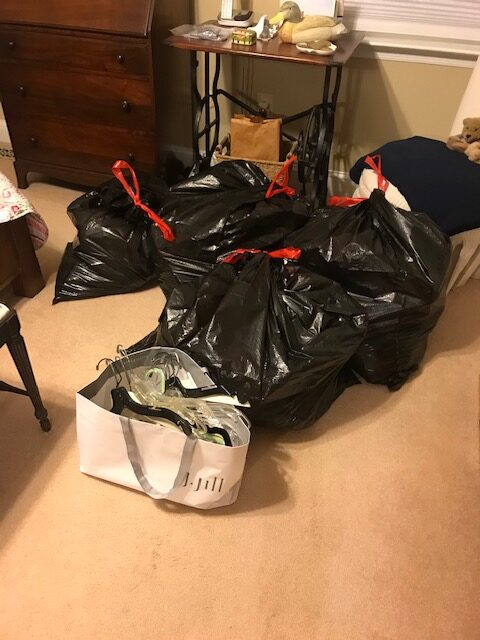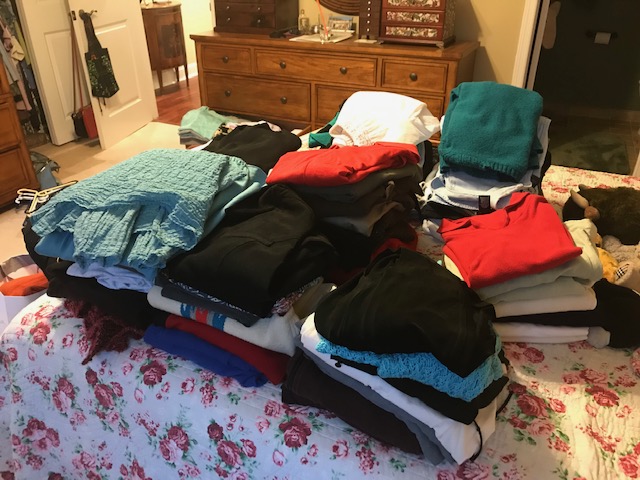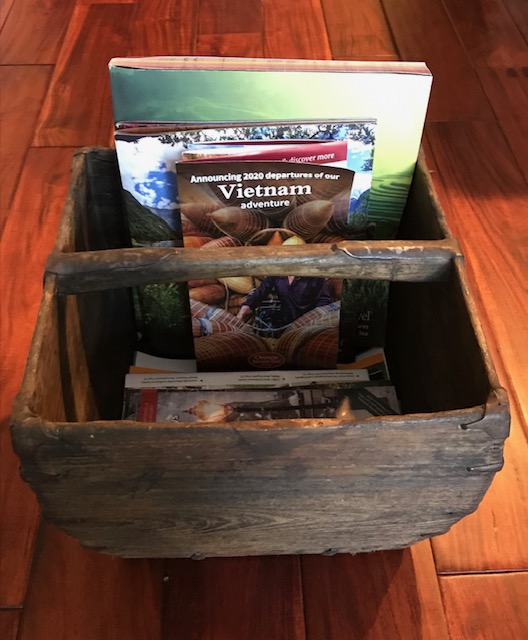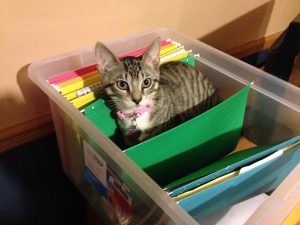
While we’ve been sheltering-in-place and social-distancing, I’ve been thinking about all the traveling I’ve done. Whether it’s a quick overnight or weekend trip or something longer, like 2 – 3 weeks, I’ve been remembering my wallet and how it gets filled with all sorts of paper not related to anything I needed to carry with me.
My wallet has been filled with receipts, ticket stubs, candy wrappers, etc. Were all these extraneous things necessary to stuff into my wallet? For me, this was the best place to keep all these items temporarily until I got home, when I could empty my wallet, file what I needed to keep in their respective “homes”, and discard the rest (I sure didn’t need to keep a candy wrapper). Do many of you have things like this in your wallet all the time?
How much you can fit in your wallet is really a metaphor for how much you can fit in your surroundings. Are you ready to “Empty Your Wallet” (and I don’t mean emptying it of money)? I’m talking about your wallet representing how light you would feel if you emptied your life of all the extraneous things that don’t need to be kept in it. What is actually important to you? What do you really need, not want, to keep in your life to make it seem less weighty? The 4 benefits of having an “empty wallet” are:
“Do not wait: the time will never be ‘just right’. Start where you stand, and work whatever tools you may have at your command and better tools will be found as you go along.” Napoleon Hill
Now is Your Time to “Empty Your Wallet”
I am the first to admit that I used a Professional Organizing colleague and friend to help me with something I’ve been meaning to do for years. She helped me go through my closets and determine what to keep and what to finally give away.
My reluctance was four-fold:
I finally bit the bullet and hired my friend. It was the best money I’d spent in a while. In four hours, we got through all my clothes closets. I had a ton of clothes and hangers to donate, all of which went to a women’s shelter in Camden, NJ. My closets have room now, I have bunches of hangers I can use for anything new that I buy, I feel free, and I know that these clothes can be used by those not as fortunate as I.


So, what does it say about a Professional Organizer asking for help from a Professional Organizer? Some of you may wonder why I couldn’t do this by myself.
Firstly, I was able to ask for help. There is nothing wrong with asking for help. We all have strengths, and we all face challenges in our lives. Why not ask for help when needed?
Secondly, what I experienced is exactly what my clients experience, and that was worth its weight in gold. I think I’m a pretty empathetic person, but this solidified it for me. I tried on clothes that I wasn’t sure about, and since my colleague was not emotionally invested in anything (but my parents bought that blouse in Greece for me a zillion years ago) and only had my best interest at heart, I was able to let go of mostly everything. I was bound and determined to get through the closets.
Thirdly, I had a stake in the game. The date was set, and I knew that since I was paying for the service, I was very prepared and determined to get through this project in a timely manner. I compared this to having a personal trainer. Once you pay for something, aren’t you more apt to follow through?
The funny thing about this is after the 4 hours, my colleague asked me if I was going to go through any of the clothes and pull things out that I think I may still want to keep. I laughed, said no, and realized I ask the same question to my clients.
Just because you have room for things, like I did, doesn’t mean you have to keep them, especially if you aren’t using them anymore. Perhaps the time is right for you to ask for help with your organizing projects.
There are times, I am sure, when you have an extra 15 minutes where you just want to sit, relax, and take a few deep breaths. There is certainly nothing wrong with self-care. However, self-care can also take on another form where you want to use those extra 15 minutes to get something done in your home or office.
In my world, of course, it has to do with de-cluttering and organizing. There have been a couple of times recently where I took that 15 minutes with a client and myself to do just that.
A client of mine moved into assisted living several months ago. During one of our sessions, as I was helping her unpack and organize, I had some extra time. I went through one of her end table drawers in the living room and was able to recycle and trash 95% of what was in the drawer – old catalogs, old address labels, etc. Now, I could make room for other items that were important for her to have nearby in her new life.

In my own life, I love to travel. I always have travel articles and catalogues that I keep in an antique rice holder box (pictured above). When I started going through my collection, I was amazed at what I could recycle – articles and catalogs that went back to 2016. Since the box never looked like it was totally overflowing, I just kept putting more articles and catalogs in it. As with my client, I was able to recycle 95% of what I had stored.
This led me to think what we can all do in 15 minutes to maintain our organizational systems. Maintenance and persistence always seem to be a huge challenge in the organizing world. Developing a system or process is 1 part of the project. Another part is maintaining or tweaking what you’ve already developed.
Consider what you can do in 15 minutes. You never know what you’ll find unless you go through these areas:
On any given day, we all make choices in our lives as to what to do with our time. With those extra 15 minutes that you have, you could sit back and relax or go through an area of your home or office to see what you no longer need. What is your choice today?

We’ve all read books and articles about how to organize. I’ve even written many articles on what to do first, what to do second, etc. However, I’ve never written about what not to do. It seems counter-intuitive to write about anything negative, but sometimes we need to discuss this aspect about de-cluttering and organizing as well.
1. Don’t buy any organizing products until you see you what you actually need. You won’t know the answer to that until you finish de-cluttering and putting like with like to figure out the size of the product/container and where it’s going to go. Why waste your time buying something, not needing it, and then having to return it? You also have to remember where you put the receipt so you can return it and either exchange it for something that will work or just return it because you don’t need it.
2. Shop in your own home or office. Once you’ve finished de-cluttering and organizing, you will likely have something empty that will work to contain the items you have decided to keep. Think of the money you could save by using something you already own.
3. Stay in one area. Don’t jump from one space to another. If you do that, you’ll have spent hours all over your house or office and not get anything done. Let’s say you want to organize your living room and you find a hairbrush in that room. You take the hairbrush to the bathroom where it should live, and next, you start working on organizing your bathroom. Then, you find something that belongs in the bedroom, so you move to the bedroom. What’s the result? You’ve now been in 3 different rooms for the past several hours and haven’t gotten anything done in any of the areas. In this example, stay in the living room. If you see that something belongs in another room, put the item in a place near where that room is.
4. Don’t bite off more than you can chew. If you only have an hour, don’t tackle your 2-car garage. You may be able to work in a small area in the garage, but if you think you can get everything done in this small window of time, you may get discouraged and not want to continue when you have more time. Remember the SMART goals – specific, measurable, achievable, realistic, and timely.
5. Remove donated items and trash right away. You’ll be amazed at how you will feel and how much room you have when these items leave your home or office. It’s almost like a breath of fresh air. And, if you put them in your car to go somewhere, deliver as soon as possible so your car doesn’t become cluttered.
 Whether your office is in your home or away from home, now is the perfect time to start getting organized for 2018. The holidays have not officially started, even though you wouldn’t know it by the decorations in some stores already. In addition, tax time will be here before you know it.
Whether your office is in your home or away from home, now is the perfect time to start getting organized for 2018. The holidays have not officially started, even though you wouldn’t know it by the decorations in some stores already. In addition, tax time will be here before you know it.
Think how you would feel if you did not use your floor for a filing cabinet. C’mon now, I know you do!
Here are 5 tips to help you get your office in order:
Productivity and efficiency will greatly improve if your office space is organized. You won’t spend an inordinate amount of time looking for things, you won’t spend additional money on items you already have, and you’ll be able to use the freed-up time doing those things that are important to you.
P.S. Now, de-clutter and organize your floor. You have just created extra space in your file cabinets and drawers in which to put those items.
Is it possible to live in a small area? You bet it is!
Most of us know people living in small houses or apartments, going to college and living in a dorm for the first time, or moving from a big home to a smaller one. Even if you don’t, you may have experienced one of these situations yourself at some point.
Did you feel challenged trying to fit everything in your new space? Does the person you know feel challenged trying to do the same thing?
If you follow these five (5) tips, it really is easier than you think:
1. Divide the space into specific areas for each activity (e.g., bill paying, watching TV, hobbies, laundry, reading, or studying). Furniture and rugs can be used to separate the different activities. For instance, your bedroom may have to act as an office plus a place to sleep and get dressed. Use a desk and file cabinet in one area of the room and the bed, bureau, and night stand in another. Keep the items in their specified areas; do not let them wander into the other activity areas.
2. Use milk crates on shelves that allow of extra space between them and the ceiling. Position the milk crate so the opening faces out. This way you’ll be able to store things both inside the milk crate and on top of it. It acts as a second shelf.
3. Use over-the-door storage units or command strips to hang things on the back of doors, in closets or on walls. You can hang items in or on them to get the items off your bed, chair, table, or desk. Don’t let them end up on the floor. The best part about command strips is that they do not damage the walls.
4. Use wall shelves to take advantage of vertical space. You can use your walls from floor to ceiling for storage.
5. Take advantage of the space under your bed. Use clear plastic bins that are specifically designed for under the bed. Measure the amount of clearance you have between the floor and the bed frame to make sure the bin fits. An option that affords you more storage space is raising the bed.
Just think, when living in a smaller area, you’ll have less to take care of. That frees up your time to do the things you want to do!